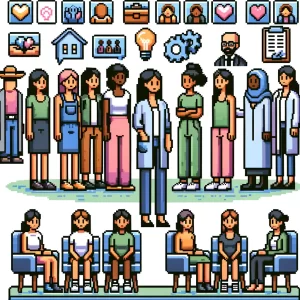
The Power of Text for Teen Vaping Cessation
Vaping among teenagers has become a significant public health concern, with over 2.1 million adolescents in the U.S. regularly using e-cigarettes in 2023 alone. While vaping may seem like a “safer” alternative to smoking, the reality is stark: the nicotine found in e-cigarettes can wreak havoc on a developing brain, impacting memory, learning, and attention. It also exposes teens to numerous harmful substances, contributing to respiratory issues, mental health problems, and, ultimately, nicotine addiction. Despite these risks, there has been little in the way of proven methods to help adolescents quit vaping—until now.
A groundbreaking study has finally delivered some hopeful news for public health professionals, parents, and teenagers alike. Researchers recently tested a tailored, interactive text message program specifically designed to help teens quit vaping, and the results were nothing short of promising. This simple, accessible intervention increased the likelihood of vaping cessation by 35% compared to a control group, marking a significant step forward in the battle against teen nicotine addiction. Let’s dive into how this program works and why it matters for the future of teen health.
A Solution Delivered to Teens’ Fingertips
We all know that teenagers love their phones, and it turns out that this ever-present technology might be key to helping them quit vaping. The study focused on adolescents between the ages of 13 and 17 who had vaped in the past 30 days and expressed a desire to quit. The program, called This is Quitting, harnesses the power of text messages to deliver personalized, supportive messages that help teens navigate the challenges of quitting.
Participants were divided into two groups: one received only periodic check-in texts for study retention purposes, while the other received a more interactive experience. This second group got daily text messages that provided cognitive and behavioral coping skills, emotional support, and reminders of the benefits of quitting. These messages were tailored based on factors such as the teen’s age and the specific e-cigarette brand they used, offering a personalized experience that felt relevant and supportive.
Even more importantly, many of the messages came directly from other teens who had gone through the quitting process. This social support element helped teens feel less isolated in their journey, creating a community of peers who understood their struggles.
The Results Speak for Themselves
At the seven-month mark, researchers found that nearly 38% of teens who received the full text message intervention reported they had quit vaping, compared to just 28% of those who were in the assessment-only group. This difference is more than just a number—it represents hundreds of teenagers who have managed to break free from nicotine addiction thanks to a simple, accessible intervention.
One of the most remarkable aspects of the study is how effective the program was across the board. No matter the teens’ gender, race, nicotine dependence level, or even their mental health status, the text message intervention worked. It shows that a well-designed, low-cost digital tool can have a profound impact, even for a population that has traditionally been hard to reach with more conventional cessation programs.
A Shift in the Landscape of Teen Vaping
This study is more than just an exciting development for vaping cessation—it represents a shift in how we think about public health interventions for teenagers. Text messaging offers a non-invasive, easily accessible, and scalable solution to a growing problem. Teenagers are digital natives, and using a technology they’re already familiar with may be the key to helping them adopt healthier behaviors. Unlike in-person counseling or other more intensive interventions, a text-based program can reach thousands, even millions, of teens across the country, making it a highly efficient tool for public health practitioners to consider.
What’s more, the program’s interactive nature taps into something that many teens crave: connection. The program’s design, which allows for the sharing of tips and encouragement from peers who have successfully quit vaping, transforms quitting into a shared experience rather than an isolating journey. This feeling of solidarity can make a huge difference when it comes to sticking with the challenging process of breaking nicotine dependence.
Why This Matters for Public Health
The significance of this research goes beyond the numbers. We now have a cost-effective, scalable method to address a critical public health issue. Nicotine addiction in adolescence doesn’t just affect teens in the short term; it increases their risk of addiction to other substances and mental health issues later in life. If we can intervene early with programs like This is Quitting, we can change the trajectory of countless young lives.
For public health practitioners, this study provides a valuable tool that can be integrated into broader tobacco prevention strategies. Clinicians working with teens can recommend this free program as an accessible resource. Community health workers, school counselors, and healthcare providers can also promote this program in clinics, schools, and online spaces where teens gather. The intervention’s simplicity and effectiveness make it a powerful addition to the arsenal of strategies aimed at reducing teen tobacco use.
Practical Takeaways
This study highlights a few key takeaways for public health professionals looking to apply these findings in the field:
- Digital-first interventions work: Engaging teens through technology they already use is an effective way to deliver support and health education. Consider integrating digital tools into your public health programs, especially for adolescent populations.
- Personalization matters: Tailoring messages to specific groups, such as by age or preferred vaping brand, can increase the impact of the intervention. A one-size-fits-all approach might not resonate with all teens, but personalizing content can make the program feel more relevant.
- Peer support is powerful: Teens often look to their peers for guidance, so including peer-generated content and experiences can foster a sense of community and belonging, which can boost the program’s effectiveness.
- Scalability is key: The program’s success demonstrates the potential of text messaging as a scalable intervention that can reach wide audiences without the need for significant resources or infrastructure.
Join the Conversation
What do you think about using technology like text messaging to help teens quit vaping? Have you had any experiences with digital health interventions that you’d like to share? Let’s keep the conversation going in the comments or on social media—your insights could help shape future approaches to public health.
Be Part of the Change – Get Weekly Updates!
Stay informed and connected. Subscribe for free and share this blog to make a difference in public health with others. If you liked this blog, please share it! Your referrals help This Week in Public Health reach new readers.



